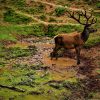The capercaillie, a large and striking woodland grouse, has become a symbol of conservation challenges in Scotland, with only about 530 remaining in the wild, primarily in Cairngorms National Park.
This impressive bird, admired for its vibrant plumage and elaborate courtship displays, has drawn the attention of birders and nature photographers eager to capture its beauty.
However, this interest poses a significant risk to the species, particularly during its breeding season from March to August, when human disturbances can severely impact breeding success.
Despite laws prohibiting disturbance during this critical time, some enthusiasts ignore these regulations.
In 2022, numerous incidents were reported, including one birdwatcher who flushed six capercaillies from their nesting site, highlighting the tension between wildlife observation and conservation.

Carolyn Robertson, project manager of the Cairngorms Capercaillie Project, emphasizes that even brief disturbances can raise stress levels in these birds, potentially preventing them from returning to breed.
The rise of social media has exacerbated the problem. While it raises awareness about vulnerable species, it also encourages over-visitation to their habitats.
A recent study revealed how online sharing can inadvertently lead to unethical practices, such as using audio calls to lure birds. Experts warn that as demand for rare sightings increases, the risk of further endangerment grows.
To counteract these threats, initiatives like the “Lek It Be” campaign have been launched, encouraging enthusiasts to refrain from seeking out capercaillie and to think twice before posting online.
This approach has led to a notable reduction in disturbance around breeding sites. The ongoing challenge remains to find a balance between the public interest in wildlife and the urgent need for conservation, ensuring that iconic species like the capercaillie are preserved for future generations.

